Welcome to the fascinating world of cheese aging! Have you ever wondered how to achieve that perfect balance of flavors and textures in your homemade cheese? Is aging cheese at home a daunting task that only experts can accomplish? Prepare to be pleasantly surprised! In this comprehensive guide, we will demystify the art of cheese aging and provide you with a step-by-step roadmap to become a master cheese ager in the comfort of your own home. Get ready to discover the secrets behind aging cheese and elevate your cheesemaking skills to a whole new level.
The Essential Elements for Aging Cheese at Home
Before you embark on your cheese aging journey, it’s crucial to understand the key elements that contribute to successful cheese maturation. The cheese aging environment plays a vital role in the development of flavors and textures. Factors such as temperature, humidity, and air circulation must be carefully regulated to create the optimal conditions for cheese aging. In this section, we will explore the importance of each element and how they impact the aging process.
Understanding the Cheese Aging Environment
Creating the right environment for cheese aging is essential to achieve the desired results. Cheeses age differently depending on various factors, including the type of cheese, its moisture content, and the specific aging technique used. A controlled aging environment helps create conditions that promote the growth of beneficial mold and bacteria while inhibiting harmful ones. This balance is crucial to develop the complex flavors and textures that make aged cheeses so desirable.
The cheese aging environment is influenced by several key factors, which we will explore in detail:
Key Factors: Temperature, Humidity, and Air Circulation
Temperature: Maintaining the right temperature is crucial for proper cheese aging. Different cheeses have specific temperature requirements, but generally, the optimal range is between 50°F and 55°F (10°C and 13°C). Lower temperatures slow down the aging process, while higher temperatures can lead to over-ripening or spoilage. It’s important to monitor and regulate the temperature throughout the aging period to achieve the desired flavor and texture development.
Humidity: Humidity levels influence the moisture content of the cheese and affect the rate at which it loses or retains moisture during aging. A humidity level of around 80% is suitable for most cheeses. High humidity prevents excessive dryness and helps the cheese develop a smooth texture. However, excessive humidity can lead to an increased risk of mold or bacteria growth. Maintaining the right balance is crucial for successful cheese aging.
Air Circulation: Adequate air circulation is necessary to ensure uniform moisture distribution and prevent the growth of unwanted mold or bacteria. It also helps eliminate excess carbon dioxide produced during the aging process. Proper ventilation allows the cheese to breathe, facilitating the development of desirable flavors. However, excessive airflow can lead to excessive moisture loss and uneven aging. Achieving the right balance of air circulation is key to successful cheese maturation.
By understanding and managing these factors, you can create an ideal environment for aging your cheese and achieve the desired flavors and textures that make artisanal cheese so exceptional.
| Factors | Optimal Range | Effects of Inappropriate Levels |
|---|---|---|
| Temperature | 50°F – 55°F (10°C – 13°C) | Too low: Slows down aging process; Too high: Over-ripening or spoilage |
| Humidity | Around 80% | Too low: Excessive dryness; Too high: Increased risk of mold or bacterial growth |
| Air Circulation | Appropriate airflow | Too low: Uneven aging; Too high: Excessive moisture loss |
How to Age Cheese: Setting Up Your Home Cheese Cave
Creating a suitable space for cheese aging is essential for achieving successful results. Whether you have a dedicated cheese cave or are working with limited space, finding the perfect spot is crucial.
Finding the Perfect Spot for Your Cheese Cave
When setting up your home cheese cave, consider the following factors to ensure optimal aging conditions:
- Temperature: Choose a location where you can easily control and maintain the desired temperature for cheese aging. Ideally, the temperature should be between 45°F and 55°F (7°C and 13°C) for most types of cheeses.
- Humidity: Cheese requires a humidity level of about 80% to 90% during the aging process. Look for a spot where you can regulate and maintain the proper humidity level to prevent the cheese from drying out or becoming too moist.
- Light: Cheese should be aged in a dark environment to protect it from light exposure, which can degrade the quality and flavor of the cheese. Avoid locations that receive direct sunlight or have bright artificial lighting.
- Air Quality: Ensure good air circulation in the cheese aging location to prevent the development of off-flavors and molds. Avoid areas with strong odors or high levels of airborne contaminants.
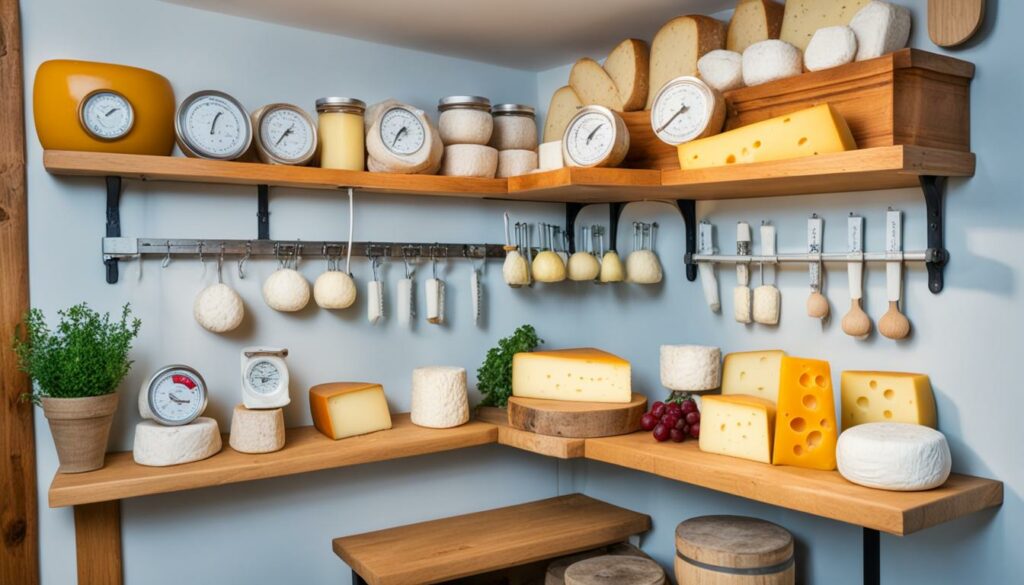
DIY Tips for a Homemade Cheese Aging Setup
If you don’t have a dedicated cheese cave, don’t worry! You can still create a homemade cheese aging setup using readily available materials. Here are some DIY tips:
- Cooler Method: Use a cooler to create a controlled environment for aging cheese. Place a small tray of water inside the cooler to maintain humidity and use an adjustable thermostat or thermometer to regulate the temperature.
- Wine Fridge Conversion: Convert a wine fridge into a cheese aging chamber. Wine fridges often have adjustable temperature and humidity settings, making them ideal for aging cheese. Monitor and adjust the settings as needed.
- Mini Refrigerator Modification: Modify a mini refrigerator by installing a humidity controller and a small fan for air circulation. This allows you to create a dedicated cheese aging space within the fridge.
- Closet Transformation: Dedicate a portion of a well-ventilated, temperature-controlled closet to cheese aging. Install shelves and use a humidifier, dehumidifier, or bowl of water to regulate humidity.
With these DIY tips, you can create the perfect cheese aging setup regardless of the space you have available.
Controlling Temperature and Humidity for Ideal Cheese Maturation
Temperature and humidity are crucial factors in creating the perfect environment for cheese maturation. Proper control and monitoring of these elements are essential for achieving the desired flavors and textures in your aged cheese. Let’s explore the techniques and equipment necessary for effectively managing temperature and humidity during the cheese aging process.
To control the temperature, you will need a reliable thermometer that accurately measures the temperature of your cheese aging space. It should be placed in a central location to ensure an accurate reading. Monitoring the temperature regularly will allow you to make any necessary adjustments to maintain the optimal temperature range for your specific cheese variety.
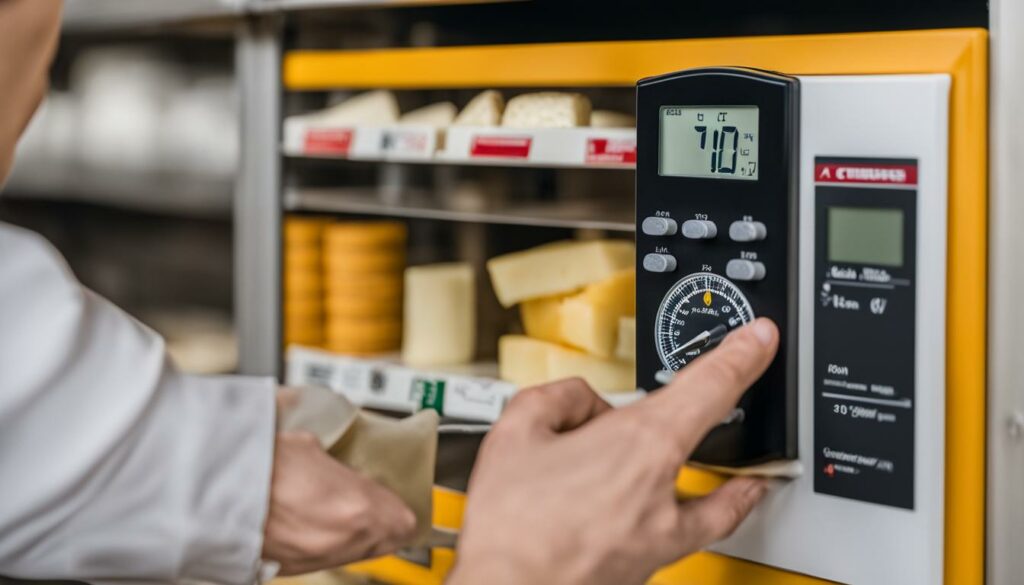
When it comes to humidity, it’s important to keep it at the appropriate level to avoid unwanted outcomes like excessive drying or excess moisture. A hygrometer is a valuable tool for monitoring humidity levels in your cheese aging area. By keeping the humidity within the recommended range, you can promote the growth of beneficial molds and encourage the development of complex flavors.
Here are some tips for controlling temperature and humidity during cheese aging:
- Ensure proper insulation in your cheese aging space to maintain a consistent temperature.
- Use a humidifier or dehumidifier, depending on whether you need to increase or decrease the humidity levels.
- Consider using cheese caves or aging containers designed specifically to regulate temperature and humidity.
- Avoid placing your cheese aging setup near heat sources or in areas with high humidity, which can affect temperature and moisture levels.
- Regularly check and adjust the temperature and humidity levels to ensure they remain within the optimal range.
By carefully controlling temperature and humidity, you can create the optimal conditions for cheese maturation, leading to the development of complex flavors, textures, and aromas in your aged cheese.
Cheese Aging Techniques for Different Cheese Types
Different types of cheese require specific aging techniques to develop their unique characteristics. Whether you’re aging soft cheeses like Camembert or hard cheeses like Cheddar, understanding the appropriate methods is crucial. Additionally, there are alternative aging techniques like waxing or brining that can be employed for certain cheese varieties. In this section, we will explore the aging techniques best suited for different types of cheeses, as well as when to utilize alternative methods.
When it comes to aging cheese, each variety has its own specific requirements. Soft cheeses, such as Brie or Camembert, need a shorter aging period, usually between 2 to 4 weeks. During this time, the cheese develops a soft, creamy texture and develops complex flavors. It is important to monitor the humidity levels and ensure proper air circulation for the best results.
On the other hand, aging hard cheeses, like Cheddar or Parmesan, is a lengthier process that can take several months or even years. Hard cheeses benefit from a drier aging environment with lower humidity levels. This encourages moisture loss, resulting in a firmer texture and sharper flavor. Temperature control is also crucial for the successful aging of hard cheeses.
In addition to these traditional aging techniques, there are alternative methods like waxing or brining that can be used for specific cheese types. Waxing is commonly employed for Gouda or Edam cheeses, creating a protective barrier that helps retain moisture and prevent mold growth. Brining, on the other hand, involves soaking the cheese in a saltwater solution, resulting in a unique flavor profile and extended shelf life.
Common Pitfalls and How to Avoid Them
While aging cheese at home can be a rewarding experience, it’s essential to be aware of common pitfalls that may arise. From mold growth to uneven ripening, various challenges can occur during the aging process. In this section, we will discuss how to identify and address these challenges to ensure successful cheese aging. Additionally, we will provide you with a handy troubleshooting chart specifically designed for cheesemaking.
Identifying and Addressing Cheese Aging Challenges
During the cheese aging process, various challenges can arise that may affect the quality and flavor of your cheese. By understanding and addressing these challenges, you can overcome them and achieve the desired results. Here are some common cheese aging challenges you may encounter:
- Mold Growth: Mold can develop on the surface of aging cheese, leading to unpleasant flavors and textures. It is essential to monitor your cheese regularly and address any mold growth promptly.
- Uneven Ripening: In some cases, different parts of the cheese may ripen at different rates, resulting in an inconsistent texture and flavor profile. This can be caused by inadequate airflow or improper temperature and humidity control.
- Off Flavors: Certain factors, such as improper handling or aging conditions, can lead to the development of off-flavors in the cheese. These flavors can range from ammonia-like to bitter or metallic.
To address these challenges, it is crucial to take proactive measures:
- Regularly inspect your cheese for any signs of mold growth. If you notice mold, carefully remove the affected area with a clean knife or cheesecloth dampened in white vinegar.
- Ensure proper air circulation by turning and flipping the cheese regularly. This will help promote even ripening and prevent the growth of mold.
- Maintain consistent temperature and humidity levels within the desired range for your specific cheese variety. Use a hygrometer and thermometer to monitor these conditions.
- Handle the cheese with clean hands and sanitize all equipment to prevent the introduction of undesirable bacteria or microorganisms during the aging process.
Consulting the Troubleshooting Chart for Cheesemaking
Having a troubleshooting chart on hand can be incredibly helpful when encountering challenges during the cheese aging process. This chart provides guidance on common issues along with possible causes and solutions. By referencing the troubleshooting chart, you can quickly identify and address problems, ensuring successful results.
Remember, each cheese variety may have its unique aging challenges, so it is essential to consult resources specific to the cheese you are aging. Additionally, don’t hesitate to seek advice from experienced cheesemakers or join cheese aging communities to learn from others’ experiences.
Conclusion
Now that you’ve reached the end of our comprehensive guide on mastering cheese aging at home, you’re equipped with the knowledge and techniques to take your cheesemaking skills to new heights. We’ve covered the essential elements of cheese aging, from understanding the cheese aging environment to controlling temperature and humidity. Additionally, we explored the process of setting up your own cheese cave and discussed various cheese aging techniques for different cheese types.
By following the techniques and tips provided in this guide, you’ll be able to create the perfect conditions for aging cheese and achieve the desired flavors and textures. Whether you’re a beginner or a seasoned cheesemaker, this guide has provided you with the tools to confidently embark on your cheese aging journey.
So, go ahead and unleash your creativity! Experiment with different cheese varieties, utilize alternative aging techniques such as waxing or brining when appropriate, and above all, enjoy the delightful journey of cheese aging in the comfort of your own home. With dedication and practice, you’ll soon be savoring the fruits of your labor – delicious, perfectly aged cheeses that are sure to impress family and friends.
FAQ
What factors contribute to successful cheese maturation?
Factors such as temperature, humidity, and air circulation play a crucial role in the development of flavors and textures during cheese aging.
How can I create a suitable space for cheese aging at home?
Whether you have a dedicated cheese cave or limited space, we will provide you with considerations for selecting the right location and practical DIY tips for setting up a homemade cheese aging setup.
How can I control temperature and humidity during the cheese aging process?
We will delve into the techniques and equipment necessary for effectively monitoring and controlling temperature and humidity, ensuring optimal conditions for cheese maturation.
Are there specific aging techniques for different types of cheese?
Yes, different types of cheese require specific aging techniques to develop their unique characteristics. We will explore the aging techniques best suited for different cheese types and alternative methods like waxing or brining.
What are some common challenges in cheese aging, and how can I address them?
Mold growth and uneven ripening are common pitfalls in cheese aging. In this section, we will discuss how to identify and address these challenges and provide you with a handy troubleshooting chart specifically designed for cheesemaking.

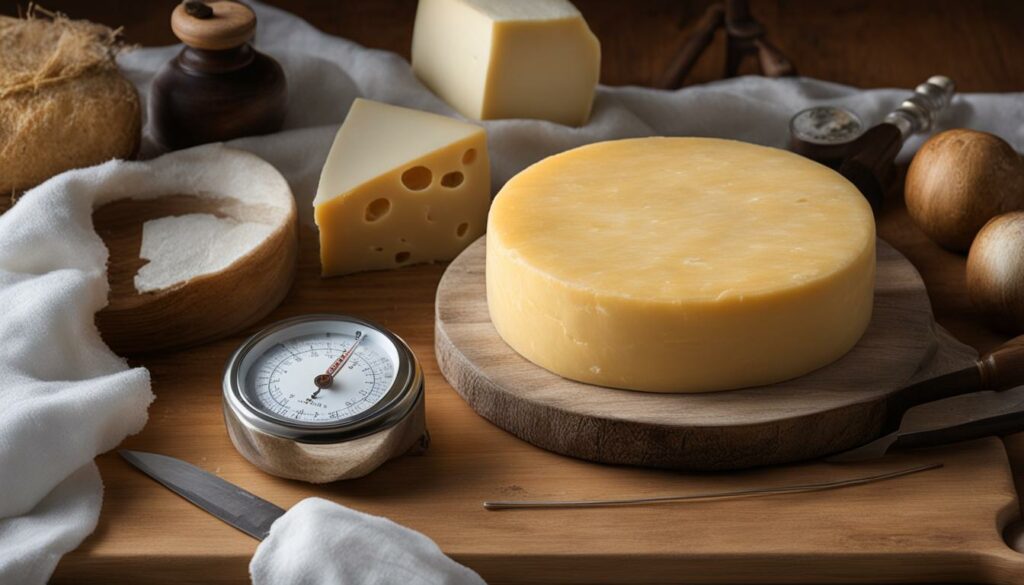
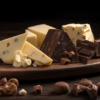


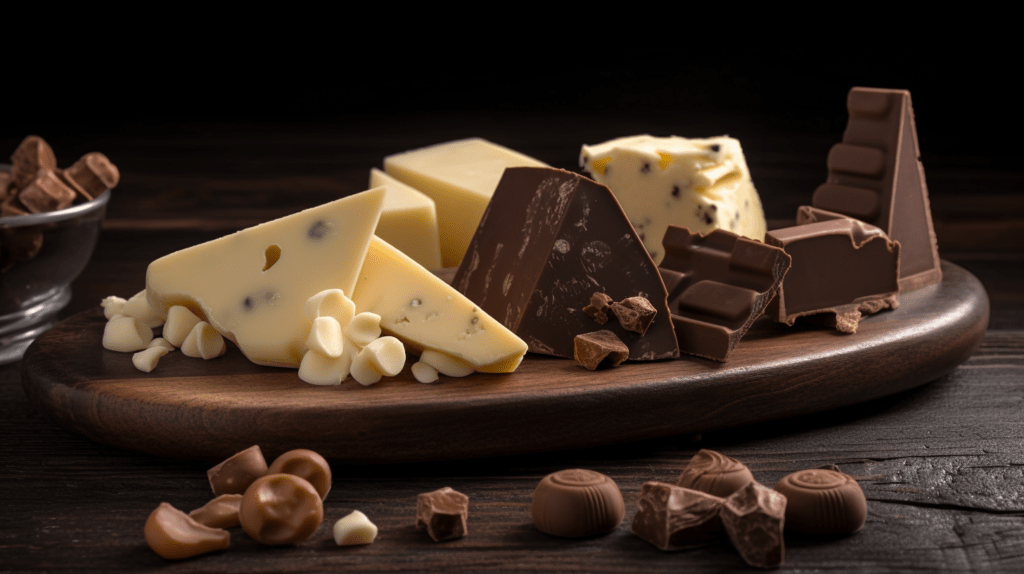

I’ve become a regular on this brilliant website, they provide wonderful content for users. The site owner works hard to inform the community. I’m a big fan and hope they continue their great service!